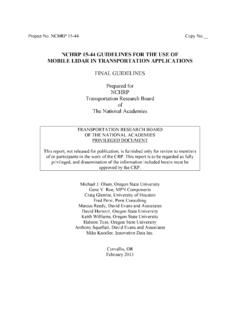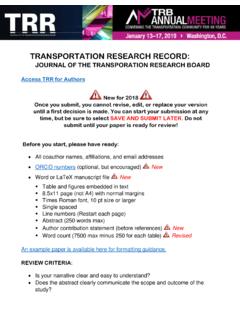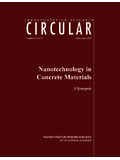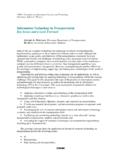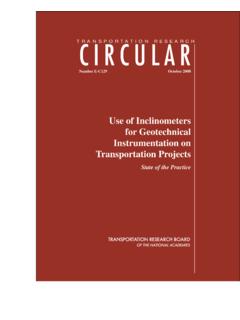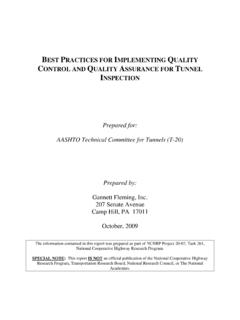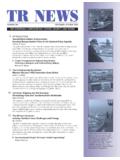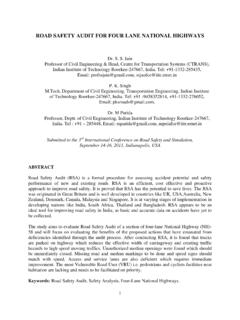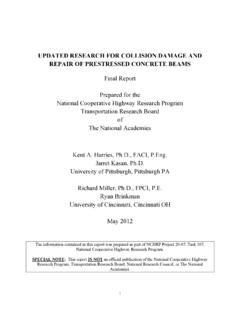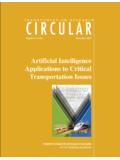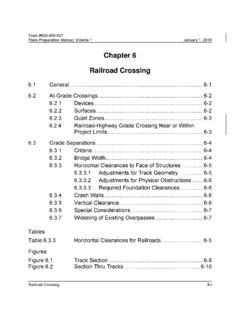Transcription of TCRP Report 19 - Transportation Research Board
1 TRANSIT COOPERATIVE Research PROGRAMSPONSORED BYThe Federal Transit AdministrationTCRP Report 19 guidelines for the Location andDesign of Bus StopsTransportation Research BoardNational Research CouncilTCRP OVERSIGHT AND PROJECTSELECTION COMMITTEECHAIRMICHAEL S. TOWNESP eninsula Transportation Dist. D. BANKSAC TransitLEE BARNESB arwood, L. BLAIRI ndiana County Transit AuthoritySHIRLEY A. DeLIBERONew Jersey Transit CorporationROD J. DIRIDONInt'l Institute for Surface TransportationPolicy StudySANDRA DRAGGOOCATALOUIS J. GAMBACCINISEPTADELON HAMPTOND elon Hampton & AssociatesEDWARD N. KRAVITZThe Flxible CorporationJAMES L. LAMMIEP arsons Brinckerhoff, LARROUSSEM adison Metro Transit SystemROBERT G. LINGWOODBC TransitGORDON J. LINTONFTAWILLIAM W. MILLARPort Authority of Allegheny CountyDON S. MONROEP ierce TransitPATRICIA S. NETTLESHIPThe Nettleship Group, E. PAASWELLThe City College of New YorkJAMES P.
2 REICHERTR eichert Management ServicesLAWRENCE G. REUTERMTA New York City TransitPAUL TOLLIVERKing County DOT/MetroFRANK J. WILSONNew Jersey DOTEDWARD WYTKINDAFL-CIOEX OFFICIO MEMBERSJACK R. GILSTRAPAPTARODNEY E. SLATERFHWAFRANCIS B. FRANCOISAASHTOROBERT E. SKINNER, EXECUTIVE DIRECTORFRANK J. CIHAKAPTASECRETARYROBERT J. REILLYTRBTRANSPORTATION Research Board EXECUTIVE COMMITTEE 1996 OFFICERSC hair: James W. VAN Loben Sels, Director, California Department of TransportationVice Chair: David N. Wormley, Dean of Engineering, Pennsylvania State UniversityExecutive Director: Robert E. Skinner, Jr., Transportation Research BoardMEMBERSEDWARD H. ARNOLD, Chair and CEO, Arnold Industries, Lebanon, PASHARON D. BANKS, General Manger, AC Transit, Oakland, CABRIAN J. L. BERRY, Lloyd Viel Berkner Regental Professor, Bruton Center for Development Studies,University of Texas at DallasLILLIAN C. BORRONE, Director, Port Commerce, The Port Authority of New York and New Jersey(Past Chair, 1995)DWIGHT M.
3 BOWER, Director, Idaho Department of TransportationJOHN E. BREEN, The Nasser I. Al-Rashid Chair in Civil Engineering, The University of Texas at AustinWILLIAM F. BUNDY, Director, Rhode Island Department of TransportationDAVID BURWELL, President, Rails-to-Trails Conservancy, Washington, DCE. DEAN CARLSON, Secretary, Kansas Department of TransportationRAY W. CLOUGH, Nishkian Professor of Structural Engineering, Emeritus, University of California,BerkeleyJAMES C. DELONG, Manager of Aviation, Denver International Airport, Denver, ColoradoJAMES N. DENN, Commissioner, Minnesota Department of TransportationDENNIS J. FITZGERALD, Executive Director, Capital District Transportation Authority, Albany, NYDAVID R. GOODE, Chair, President and CEO, norfolk southern CorporationDELON HAMPTON, Chair and CEO, Delon Hampton & AssociatesLESTER A. HOEL, Hamilton Professor, Civil Engineering, University of VirginiaJAMES L.
4 LAMMIE, Director, Parsons Brinckerhoff, Inc., New York, NYROBERT E. MARTINEZ, Secretary of Transportation , Commonwealth of VirginiaCHARLES P. O'LEARY, JR., Commissioner, New Hampshire Department of TransportationCRAIG E. PHILIP, President, Ingram Barge Co., Nashville, TNWAYNE SHACKELFORD, Commissioner, Georgia Department of TransportationLESLIE STERMAN, Executive Director, East-West Gateway Coordinating Council, St. Louis, MOJOSEPH M. SUSSMAN, JR East Professor, Civil and Environmental Engineering, MITMARTIN WACHS, Director, University of California Transportation Center, BerkeleyEX OFFICIO MEMBERSMIKE ACOTT, President, National Asphalt Pavement AssociationROY A. ALLEN, Vice President, Research and Test Department, Association of American RailroadsJOE N. BALLARD, Chief of Engineers and Commander, Army Corps of EngineersANDREW H. CARD, JR., President and CEO, American Automobile Manufacturers AssociationTHOMAS J.
5 DONOHUE, President and CEO, American Trucking AssociationsFRANCIS B. FRANCOIS, Executive Director, American Association of State Highway andTransportation OfficialsDAVID GARDINER, Administrator, Environmental Protection AgencyJACK R. GILSTRAP, Executive Vice President, American Public Transit AssociationALBERT J. HERBERGER, Maritime Administrator, Department of TransportationDAVID R. HINSON, Federal Aviation Administrator, Department of TransportationT. R. LAKSHMANAN, Director, Bureau of Transportation Statistics, Department ofTransportationGORDON J. LINTON, Federal Transit Administrator, Department of TransportationRICARDO MARTINEZ, National Highway Traffic Safety Administrator, Department ofTransportationJOLENE M. MOLITORIS, Federal Railroad Administrator, Department of TransportationDHARMENDRA K. (DAVE) SHARMA, Research and Special Programs Administrator, of TransportationRODNEY E.
6 SLATER, Federal Highway Administrator, Department of TransportationTRANSIT COOPERATIVE Research PROGRAMT ransportation Research Board Executive Committee Subcommittee for TCRPJAMES W. VAN LOBEN SELS, California Department of Transportation (Chair)DENNIS J. FITZGERALD, Capital District Transportation Authority, Albany, NYLILLIAN C. BORRONE, The Port Authority of New York and New Jersey (Chair)LESTER A. HOEL, University of VirginiaGORDON J. LINTON, Department of TransportationROBERT E. SKINNER, JR., Transportation Research BoardDAVID N. WORMLEY, Pennsylvania State UniversityTRANSIT COOPERATIVE Research PROGRAMR eport 19 guidelines for the Location andDesign of Bus StopsTEXAS Transportation INSTITUTETEXAS A&M Research FOUNDATIONTEXAS A&M UNIVERSITYC ollege Station, TXSubject AreaPublic TransitPlanning and AdministrationResearch Sponsored by the Federal Transit Administration inCooperation with the Transit Development CorporationTRANSPORTATION Research BOARDNATIONAL Research COUNCILNATIONAL ACADEMY PRESSW ashington, 1996 TRANSIT COOPERATIVE Research PROGRAMThe nation's growth and the need to meet mobility,environmental, and energy objectives place demands on publictransit systems.
7 Current systems, some of which are old and in needof upgrading, must expand service area, increase service frequency,and improve efficiency to serve these demands. Research isnecessary to solve operating problems, to adapt appropriate newtechnologies from other industries, and to introduce innovationsinto the transit industry. The Transit Cooperative Research Program( tcrp ) serves as one of the principal means by which the transitindustry can develop innovative near-term solutions to meetdemands placed on need for tcrp was originally identified in TRB SpecialReport 213 Research for Public Transit: New Directions,published in 1987 and based on a study sponsored by the UrbanMass Transportation Administration now the Federal TransitAdministration (FTA). A Report by the American Public TransitAssociation (APTA), Transportation 2000, also recognized theneed for local, problem-solving Research .
8 tcrp , modeled after thelongstanding and successful National Cooperative HighwayResearch Program, undertakes Research and other technicalactivities in response to the needs of transit service providers. Thescope of tcrp includes a variety of transit Research fields includingplanning, service configuration, equipment, facilities, operations,human resources, maintenance, policy, and administrative was established under FTA sponsorship in July by the Department of Transportation , tcrp wasauthorized as part of the Intermodal Surface TransportationEfficiency Act of 1991 (ISTEA). On May 13, 1992, a memorandumagreement outlining tcrp operating procedures was executed bythe three cooperating organizations: FTA; the National Academy ofSciences, acting through the Transportation Research Board (TRB); and the Transit Development Corporation, Inc.
9 (TDC), anonprofit educational and Research organization established byAPTA. TDC is responsible for forming the independent governingboard, designated as the tcrp Oversight and Project Selection(TOPS) problem statements for tcrp are solicited periodicallybut may be submitted to TRB by anyone at any time It is theresponsibility of the TOPS Committee to formulate the researchprogram by identifying the highest priority projects. As part of theevaluation, the TOPS Committee defines funding levels andexpected selected, each project is assigned to an expert panel,appointed by the Transportation Research Board . The panelsprepare project statements (requests for proposals), selectcontractors, and provide technical guidance and counsel throughoutthe life of the project. The process for developing Research problemstatements and selecting Research agencies has been used by TRB inmanaging cooperative Research programs since 1962.
10 As in otherTRB activities, tcrp project panels serve voluntarily Research cannot have the desired impact if products failto reach the intended audience, special emphasis is placed ondisseminating tcrp results to the intended end users of theresearch: transit agencies, service providers, and suppliers. TRBprovides a series of Research reports, syntheses of transit practice,and other supporting material developed by tcrp Research . APTA will arrange for workshops, training aids, field visits, and otheractivities to ensure that results are implemented by urban and ruraltransit industry tcrp provides a forum where transit agencies cancooperatively address common operational problems. The tcrp results support and complement other ongoing transit Research andtraining Report 19 Project A-10 FY'94 ISSN 1073-4872 ISBN 0-309-06050-8 Library of Congress Catalog Card No.
